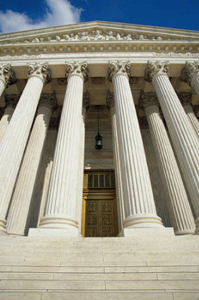 Last week, The Supremes once again stepped into an area of science/law where their limited knowledge of both fields will create more harm than good. The Supremes' say that the problem with isolated and purified DNA is that it is not chemically distinct from naturally occurring DNA, like cDNA, but persons of skill in the art recognize their reasoning is wrong. At a minimum, the bonding structure at the ends of the isolated and purified DNA have been inherently and unavoidably changed. Thus, the distinction between cDNA and purified and isolated DNA is a difference of degree not of kind as reasoned by The Supremes.
Last week, The Supremes once again stepped into an area of science/law where their limited knowledge of both fields will create more harm than good. The Supremes' say that the problem with isolated and purified DNA is that it is not chemically distinct from naturally occurring DNA, like cDNA, but persons of skill in the art recognize their reasoning is wrong. At a minimum, the bonding structure at the ends of the isolated and purified DNA have been inherently and unavoidably changed. Thus, the distinction between cDNA and purified and isolated DNA is a difference of degree not of kind as reasoned by The Supremes.
The Supremes' deeper mistake is they have, once again, been persuaded by those who conflate the concepts of prior art patentability with the concept of statutory patentability in order to get short term benefit in trade for long term progress. It is perhaps true that isolating and purifying DNA is no longer patentable today. But that situation is because the science of molecular biology has progressed to the point where such advancements are now relatively obvious to persons skilled in the art. That situation certainly was not true in 1983 when an Amgen scientist isolated and purified the DNA for erythropoietin and forever changed the world for patients with kidney failure. And "but for" that earth changing event by Fu Kwen Lin, who can say whether any of the subsequent discoveries by other Amgen scientists would have occurred.
 Therein lays the future mischief that will result from The Supremes' latest decision. In modern parlance, a core aspect of the patent system is to encourage the capital formation which is needed to tackle the ever-increasingly-difficult challenges that our society faces. Without the incentive to form the capital pools necessary to tackle increasingly sophisticated and complex problems, technical advances will slow to lower pace. Perhaps that's a good thing. Perhaps we have achieved such rapid technical advance over the past 30+ years that we need to slow down for a while, i.e., to give the world a chance to digest all that has been accomplished.
Therein lays the future mischief that will result from The Supremes' latest decision. In modern parlance, a core aspect of the patent system is to encourage the capital formation which is needed to tackle the ever-increasingly-difficult challenges that our society faces. Without the incentive to form the capital pools necessary to tackle increasingly sophisticated and complex problems, technical advances will slow to lower pace. Perhaps that's a good thing. Perhaps we have achieved such rapid technical advance over the past 30+ years that we need to slow down for a while, i.e., to give the world a chance to digest all that has been accomplished.
But that slower pace will provide little comfort to patients having a decision whose treatment lies hidden in the leaves of a plant growing in the Amazon forest or inside an insect trapped in an amber rock buried in an African mine. We have, today, many companies and scientists whose existence is devoted to unlocking such compounds so that they can be used as medicines. A core mischief of The Supremes' latest decision is that it virtually assures that enormous work of isolating, identifying, and making these compounds available for society will no longer be rewarded with patent protection. That result won't deter scientists from trying to continue their work; many scientist will still work hard, devoting their energy to unlocking these secrets of nature. But The Supremes' decision will most definitely deter the money-people, those who provide the money that supports the efforts of those scientists. The money-people will look elsewhere, and many of them will find other opportunities. With less monetary support, there will be fewer scientists looking. And with fewer scientists looking, there will be fewer discoveries. It's particularly unfortunate that this decision comes at a time when the government, too, is cutting support for science.